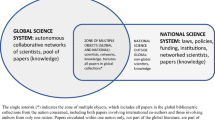Abstract
Using recent original data from three different sources, the article exhibits some strengths and weaknesses of science in Colombia. It shows that research in this country is in a process of growth although recent results of this positive trend are still to be confirmed. Comparing the evolution of science in Colombia with that of Latin America as a whole, describing and explaining its geographical and institutional concentration as well as its thematic distribution, it also reveals the interdependance between science production dynamics and international cooperation programmes. A basic argument is that the development of science in this country, even though it is fragile and erratic, does not lack sound bases. The indicators used suggest indeed an autonomous scientific motion and inspiration which does not contradict the internationalization process of Colombian science but rectifies the picture of an excessively isolated or dependent community that used to be portrayed.
Similar content being viewed by others
Notes and references
J. L. Villaveces, Ciencia en un contexto de apertura, in COLCIENCIAS, Departamento Nacional de Planeacion, Ciencia y tecnologia para una sociedad abierta, COLCIENCIAS, Bogota, 1991, 29–52 citing data fromP. J. Amaya, Science in Colombia. In:Guardiola, Villaveces, Violini (Eds),Status and Problems of Science in Latin America and the Caribbean, Academia Colombiana de Ciencias, Centro Internacional de Fisica, Bogota, 1990.
N. Narvaez-Berthelemot, La colaboracion internacional: una estrategia de visibilidad de la ciencia, Colombia,Ciencia y Technologia, 11 (No. 1) (1993) 15–18.
M. Leclerc, La coopération scientifique internationale, exemple du Canada,La Recherche, 24 (No. 252) (1993) 350–357.
R. Arvanitis, J. Gaillard, Vers un renouveau des indicateurs de science pour les Pays en voie de développement. In:R. Arvanitis, J. Gaillard (Eds),Science Indicators for Developing Countries, ORSTOM Editions, Paris, 1992, pp. 9–36.
SeeR. Arvanitis, Y. Chatelin, National scientific strategies in tropical soil sciences,Social Studies of Science, 18 (1988) 113–146;R. Arvanitis, J. Gaillard, (Eds),op. cit. Science Indicators for Developing Countries, ORSTOM Editions, Paris, 1992, pp. 9–36.
M. Callon, J-P. Courtial, H. Penant,La scientométrie, PUF Que sais-je?, Paris, 1993.
On this inclusive and descriptive term for the quantitative study of science, seeM. Krauskopf, Epistemometria, a term contributing to express the meaning and potential methodologies of scientometrics in Spanish speaking countries,Scientometrics, 30 (1994) 423–428.
Science et Technologie: indicateurs 1994. Rapport de l'Observatoire des Sciences et des Techniques, Economica, Paris, 1993.
R. Villegas, G. Cardoza, Status of World Science: Latin America, World Science report, UNESCO, Paris, 1993, pp. 29–44.
For the distribution of production in Latin America, see:M. Krauskopf, R. Pessot, R. Vicuna, Science in Latin America, How Much and along what lines?Scientometrics, 10 (1986) 199–206;P. Mc Lauchlan de Arreghi, M. Torero Cullen,Indicadores de Ciencia y Tecnologia en America Latina, 1970–1990, Grade, Lima 1991;R. Villegas, G. Cardoza,op. cit. Status of World Science: Latin America, World Science report, UNESCO, Paris 1993, pp. 29–44.
The general decrease for the year 1989 is explained by a change in the forms of collecting data for PASCAL for every country.
This situation may be compared to convergent results presented for other Latin American countries: Argentina, Brazil, Mexico, Venezuela. See:H. Vessuri, La institucionalización de las ciencias básicas en América Latina. Problemas y perspectivas, 1991, mimeo.
SeeN. Narvaez-Berthelemot, L. P. Frigoletto, J.-F. Miquel, International scientific collaboration in Latin America,Scientometrics, 24 (1992) 373–392.
To be compared with the figure of 4449 researchers, including social sciences, which do not appear here; source: ACAL, UNESCO, In:R. Villegas, G. Cardoza,op. cit..
These are definitely Spanish Latin American names; considering the low level of co-authorship in Latin America followingN. Narvaez-Berthelemot, (1992),op. cit.,. We can logically deduce that the population which appears here is Colombian in its majority.
N. Narvaez-Berthelemot, (1992) and (1993),op. cit.; ;R. Villegas, G. Cardoza, (1993),op. cit. Status of World Science: Latin America, World Science report, UNESCO, Paris, 1993, pp. 29–44.
This would be 63.6% according toM. Leclerc, (1993),op. cit..
Author information
Authors and Affiliations
Rights and permissions
About this article
Cite this article
Meyer, J.B., Charum, J., Granés, J. et al. Is it opened or closed? Colombian science on the move. Scientometrics 34, 73–86 (1995). https://doi.org/10.1007/BF02019174
Received:
Issue Date:
DOI: https://doi.org/10.1007/BF02019174




